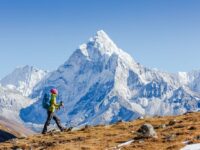The Annapurna Base Camp Trek: A Complete Guide
Introduction
The Annapurna Base Camp Trek is one of the most well-known trekking routes in Nepal. It’s simple and less strenuous but still offers a variety of culture, landscapes, and unbroken lifestyles as well as the most breathtaking and intimate views that is The Annapurna trail, Machhapuchhre, Hiunchuli and Dhaulagiri.
Annapurna Base Camp trek, sometimes referred to in the form of Annapurna Sanctuary , gives a stunning array of ecosystems because of the unique mixing of height and depth. It is situated near to massive snow mountains, particularly Annapurna Himalayan ranges as well as other peaks that are above the 7000m mark. It gets just seven hours of sunshine every day in the summer.
A dense tropical forest of Rhododendron and bamboo covers the slopes to the south and the slopes that face north are shaded in rain shadows. The sanctuary is a place of worship for both Hindus as well as Buddhists since there is a belief that it’s the home to their deities. Annapurna Sanctuary was never open to foreign tourists until 1956.
It is among the most amazing Nepal treks that includes numerous cultural and ethnic groups like Gurung, Magar, Thakali and also a stunning view of fauna and flora.
Details of the Annapurna Base Camp Trek
Highlights of the Trek
The most memorable aspects of the trek are views of the mountain ranges and pinnacles stunning dawns and dusks that are breathtaking and terraced farms, as well as enough time to travel towards towns which are home to locals of various backgrounds and an opportunity to experience the Himalayan way of living.
The trek begins after a few hours of travel or drive from Pokhara. The trek takes you through cities inhabited by people from different ethnicities which are mostly those belonging to the Gurung as well as the Pun community residents. The trek allows you to get to know Nepali people going about their routines and daily activities. The farmlands, settlements and backwoods are linked to one another , however the arrangement is more risky at higher elevations.
Annapurna Base Camp Trek includes Ghorepani Poonhill Trek too. In spring, the woods in this area are utilized to bloom with Rhododendrons. Poonhill offers a stunning view of the mountains of The Annapurna run, and gives visitors a glimpse of the beauty to be seen in the coming years.
Looking through Annapurna photos, will provide you with an idea of what to expect during your expedition. Additionally, since Machhapuchhre Base Camp comes on the route from Annapurna Base Camp, you will also be able to reach the top on Mount Fishtail near to the Pokhara.
Fauna and Flora can be observed on the Trek
The area is habitat for a range of species, including obfuscated panthers Himalayan Tahr Himalayan Giant Honeybee, Pheasants and numerous others.
The spring months are when it is able to display numerous stunning blossoms including the national flower in Nepal which is Rhododendron. Flowers, Machhapuchhre mountain range and one of Nepal’s most well-known deep valleys, Kali Gandaki remains alongside you throughout the trekking.
Various Vantage Points Along the Trek
You can spot the cascading waterfalls that are steep at times during your trek. Additionally, you’ll be able to seek out people from various ethnic groups particularly those of the Gurung People during a visit to the Gurung Museum in Ghandruk.
In the event that you do, based on which route you choose You may not be able to pass through Ghandruk perhaps. The path is very identical to Chom Rung yet you can combine or even eliminate Ghorepani Poon Hill and Ghandruk.
Poon slope is one of the pin points from Annapurna’s perspective as well as a host of other pinnacles at dusk and dawn.
The different aspects of this hike include hot springs! Unwinding your muscles and convalescing the muscles you’ve reverberated.
Best time to take this hike.
It is possible to trek the Annapurna Base Camp Trek is accessible throughout the year.
However, being sucked into the storm could be dangerous. The majority of the time falls at night.
Leeches and rain can also cause indirect mosquitoes, and possibly an avalanche. This is also the time that tiny flying and ground creatures tend to be active.
First, let us look at the seasons.
In Nepal the Nepali calendar has six seasons in Nepal:
- Spring (March to May)
- Summer/Monsoon (June to August)
- Pre-winter (September to November)
- Winter (December to February)
It is best to wait until winter to take this amazing hike. It is a dry time with clear blue skies. It is the ideal time to go on any trekking in Nepal.
You are able to visit even in December if you’d like to avoid being packed. ABC can also be visited in winter. In winter, you’ll have clear skies and dry air.
Since the beginning of January, you’ll be able to see floods of slides starting from Deurali through Machhapuchhre Base Camp.
Spring is one of the most ideal times to undertake an Annapurna Base Camp hike.




